It’s time to dehydrate carrots. We just harvested buckets of carrots and I can only store so many of them in the fridge or freezer. My detached garage is unheated and my basement is too warm so neither of those are options for long term dry storage (read more about harvesting and storing carrots). That leaves dehydrating, a process that will allow me to keep carrots without worry for at least a year.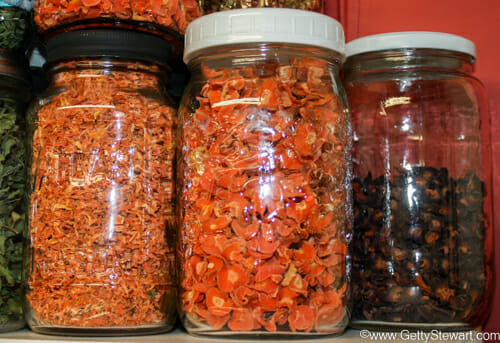
I use dried carrots by tossing them directly into soups, stews or casseroles. Others I use when making homemade soup mix in a jar. I’m also thinking of making some carrot powder (simply grinding the dried carrots in a coffee grinder or food processor) to use in cakes, smoothies, soup, breads, pancakes, etc. Sort of like what I did with my beet root powder.
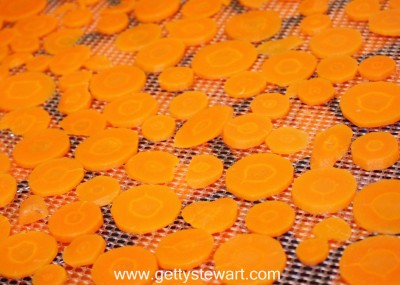
BLANCH BEFORE YOU DEHYDRATE CARROTS
Some dehydrating sites say you do not have to blanch carrots before drying. As much as I love a good short-cut, I highly recommend that you DO blanch carrots before dehydrating. WHY? Because you get better results. Blanching stops enzyme action that causes loss of color, texture and flavor. In dehydrating it also shortens the drying and re-hydration time, keeps dried veggies fresh for longer, and kills microorganisms that could induce spoilage.
See for yourself. I dried the same variety of carrots at exactly the same time for the same length of time and stored them in the same container for 3 months. The white carrots are those that weren’t blanched, the orange carrots are those that were blanched. Which would you rather have?!
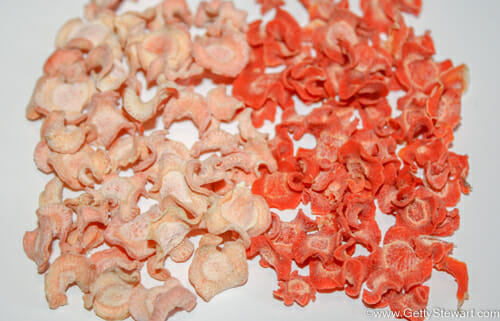
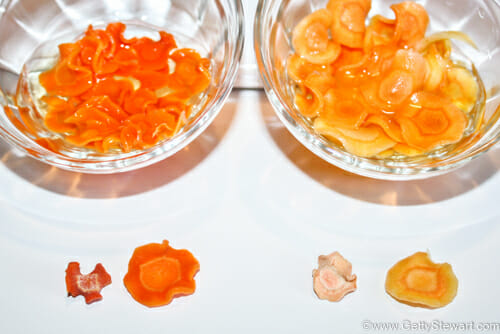
The Colorado State University Extension Office says this about blanching:
Pretreating vegetables by blanching in boiling water or citric acid solution is recommended to enhance the quality and safety of the dried vegetables (see Table 2). Blanching helps slow or stop the enzyme activity that can cause undesirable changes in flavor and texture during storage. Blanching also relaxes tissues so pieces dry faster, helps protect the vitamins and color and reduces the time needed to refresh vegetables before cooking. In addition, research studies have shown that pretreating vegetables by blanching in water or citric acid solution enhances the destruction of potentially harmful bacteria during drying, including Escherichia coli O157:H7, Salmonella species and Listeria monocytogenes.
With that said, here are the steps to dehydrating carrots – including blanching!
HOW TO DEHYDRATE CARROTS
STEP 1
Wash and trim tips and greens off of carrots. Peeling is optional – I did not peel mine because I just harvested them and gave them a good scrubbing.
STEP 2
Use a mandolin or food processor to cut carrots into coins about 1/8 inch (3mm) thick. You could also shred carrots and dry them as such – great for carrot cake!
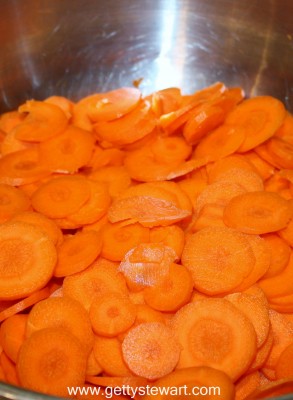
STEP 3
To blanch carrots toss into boiling hot water, wait for water to come back to a full boil, then boil for 3 minutes. Remove from heat and immediately cool in an ice water bath and drain well. For more details on blanching read Blanching and Freezing Carrots, or Blanching and Freezing Shredded Carrots.
STEP 4
Spread carrots out on dehydrator trays in a single layer to allow for plenty of air circulation.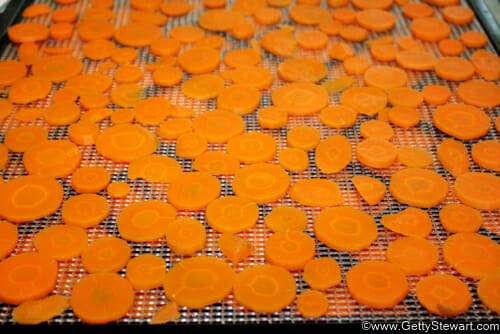
And, yes you can dehydrate shredded carrots too. Follow the same general process except shred the carrots before blanching (blanch for 2 minutes). Lay out on the drying sheets as thinly and evenly as possible – a little overlapping is okay. Then dry as recommended below. Shredded carrots will take about 6- 10 hours. Read more about blanching shredded carrots.
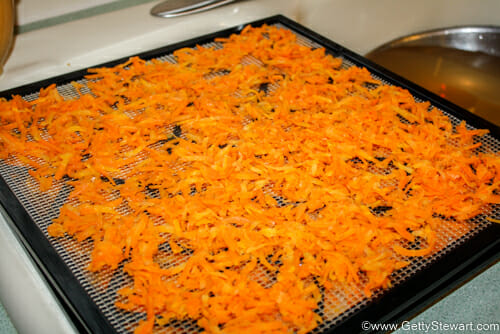
STEP 5
Dehydrate carrots at 125°F or 52°C until they are leathery to crisp. Depending on humidity levels this can take 12 to 24 hours.

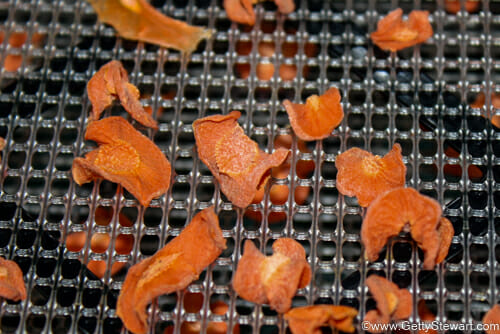
STEP 6
Allow carrots to cool thoroughly before storing in airtight jars. Just turn the dehydrator off and let them sit for another 6-8 hours. This ensures that there won’t be any condensation build up on the inside of the jars.
STEP 7
Store in airtight containers in a cool, dry, dark place for up to one year.
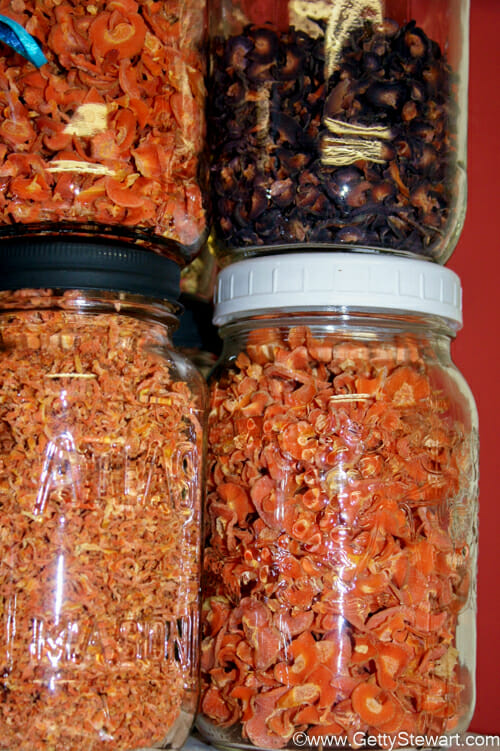
HOW TO REHYDRATE CARROTS
When making soups or stews that have a lot of moisture and require cooking for more than 15 minutes, simply toss dried carrots directly into the dish. Depending on the recipe, you may need to add additional liquid at some point during the cooking process.
In other recipes like rice pilaf, stir-fry’s, casseroles, side dishes, and so on it’s best to re-hydrate the carrots before using. Whenever possible, use the rehydrating liquid in your recipe to retain vitamins and minerals.

I added re-hydrated carrots to this ham and peas mac and cheese.
To rehydrate carrots:
- for every 1 cup dried carrots use 2 1/4 cup water
- in large bowl pour water over dried carrots – hot or boiling water will soak up more quickly
- let soak at least 15 to 30 minutes before using
- use enough water to completely cover the carrots – about 2 1/4 cups for every 1 cup of carrots
- 1 cup dried carrots reconstitutes to about 2 cups cooked carrots
The longer you let them soak, the more they plump up and look just like regular cooked carrots.
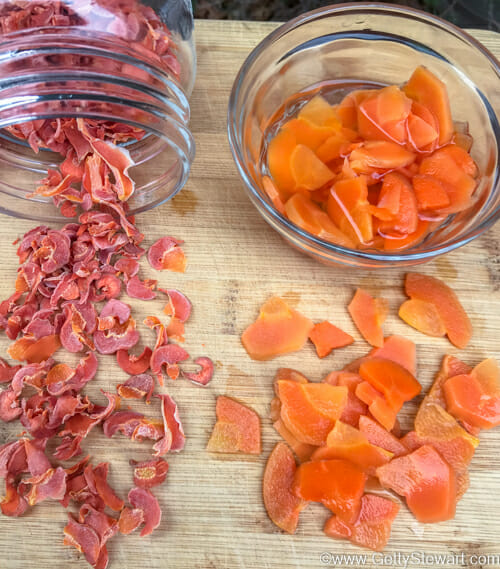
Let me know if you dehydrate carrots and how you use them. I’d love to hear about your experiences. And, if you’re on social media, take a photo and tag #getgettys so I can see it and like it!












